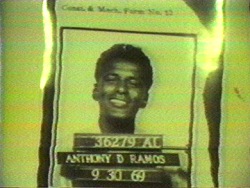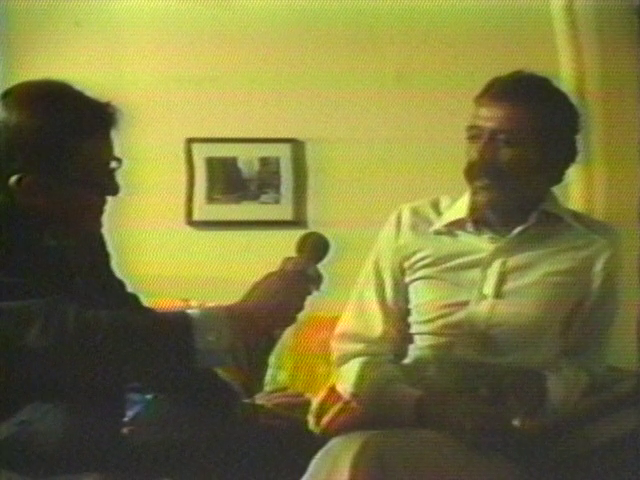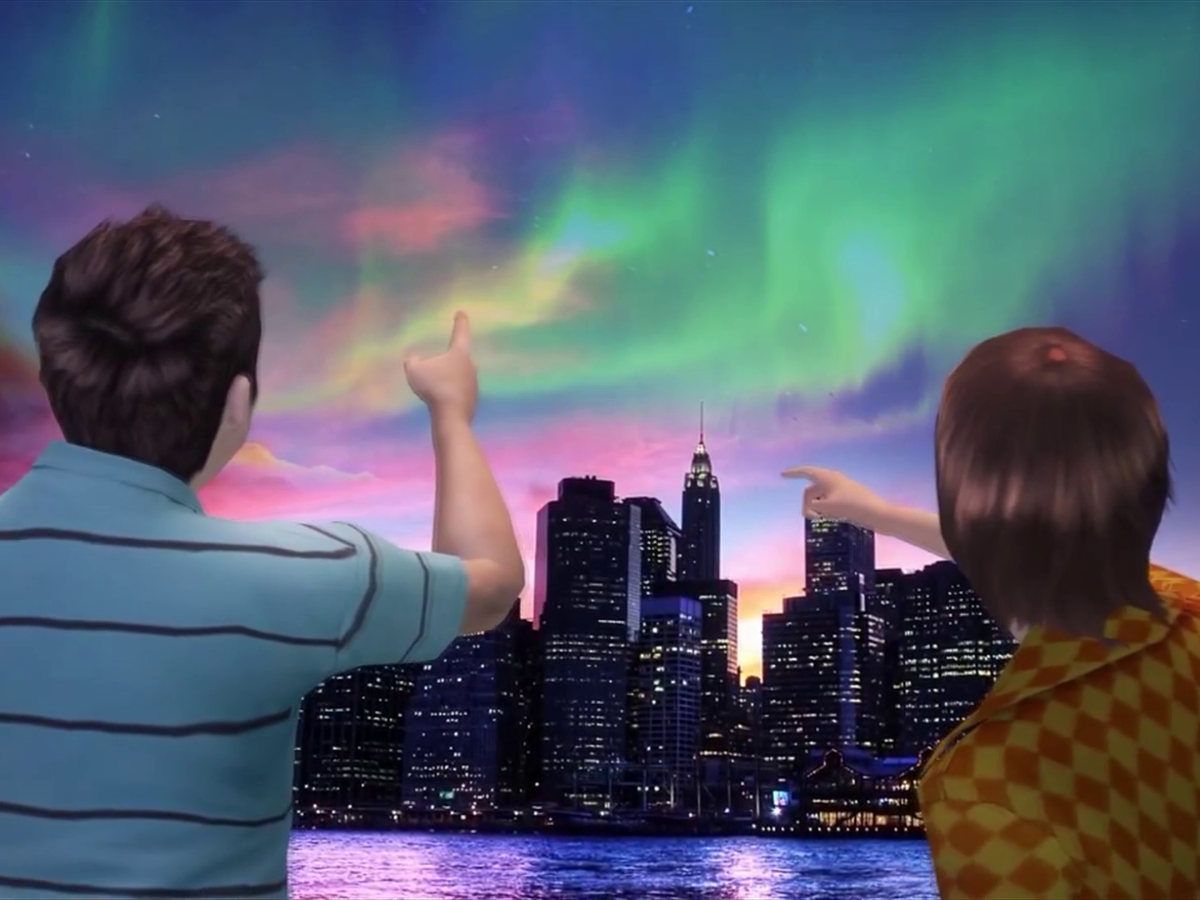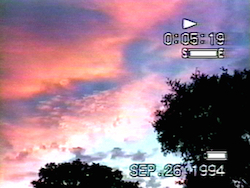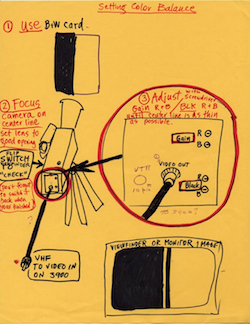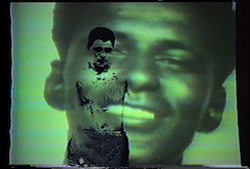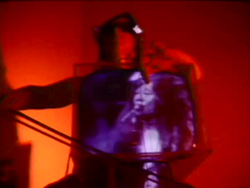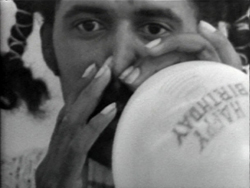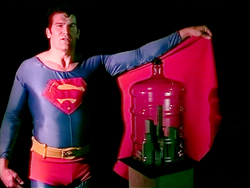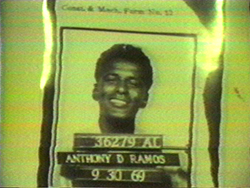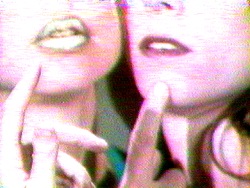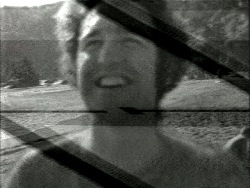Anthony Ramos
Related EAI Public Programs
Nor Was This All by Any Means: A Career-Spanning Conversation with Anthony Ramos
Electronic Arts Intermix (EAI) 264 Canal Street #3W
New York, NY 10013
Saturday, April 22, 2:00 pm (selected works on view), 3:00 pm (conversation)
RSVP here. Seating is first come, first serve. RSVP does not guarantee entry, but helps us track interest and send event updates and reminders.
Electronic Arts Intermix (EAI) is pleased to host a career-spanning conversation between Ramos and scholar Catherine Quan Damman, touching upon Ramos’s varied activities as an artist. Ramos is counted among the earliest artists to use video as a tool for mass media critiques and cultural documentation, and to examine media presentations of “truth.” A significant but underrecognized figure in both East and West coast art scenes—he had been a close student of Allan Kaprow at CalArts and a friend and peer of important video figures such as Nam June Paik and Juan Downey—Ramos produced a varied body of work, ranging from deliberately confrontational direct-camera performance to provocative essayistic compositions using appropriated material as a satirical counterpoint. Selected video-performances will be on display from 2:00 to 3:00 pm, followed by a screening of Ramos’s Nor Was This All By Any Means, a densely-layered work exploring personal and cultural heritage, capturing disparate landscapes from Harlem to Goree Island, Cape Verde and Tanzania.
Part of Nor Was This All By Any Means: A Career-Spanning Series with Anthony Ramos
Catherine Quan Damman is the Linda Nochlin Visiting Assistant Professor of Art History at the Institute of Fine Arts, New York University, where she teaches and advises graduate work on feminist and queer approaches to global modern and contemporary art. She is completing her first monograph, Performance: A Deceptive History, with the support of a 2022–2023 ACLS Fellowship, and is a frequent contributor to Artforum and other publications.
Electronic Arts Intermix (EAI) is pleased to host a career-spanning conversation between Ramos and scholar Catherine Quan Damman, touching upon Ramos’s varied activities as an artist. Ramos is counted among the earliest artists to use video as a tool for mass media critiques and cultural documentation, and to examine media presentations of “truth.” A significant but underrecognized figure in both East and West coast art scenes—he had been a close student of Allan Kaprow at CalArts and a friend and peer of important video figures such as Nam June Paik and Juan Downey—Ramos produced a varied body of work, ranging from deliberately confrontational direct-camera performance to provocative essayistic compositions using appropriated material as a satirical counterpoint. Selected video-performances will be on display from 2:00 to 3:00 pm, followed by a screening of Ramos’s Nor Was This All By Any Means, a densely-layered work exploring personal and cultural heritage, capturing disparate landscapes from Harlem to Goree Island, Cape Verde and Tanzania.
Part of Nor Was This All By Any Means: A Career-Spanning Series with Anthony Ramos
Catherine Quan Damman is the Linda Nochlin Visiting Assistant Professor of Art History at the Institute of Fine Arts, New York University, where she teaches and advises graduate work on feminist and queer approaches to global modern and contemporary art. She is completing her first monograph, Performance: A Deceptive History, with the support of a 2022–2023 ACLS Fellowship, and is a frequent contributor to Artforum and other publications.
Nor Was This All by Any Means: A Career-Spanning Conversation with Anthony Ramos
Electronic Arts Intermix (EAI) 264 Canal Street #3W
New York, NY 10013
Saturday, April 22, 2:00 pm (selected works on view), 3:00 pm (conversation)
RSVP here. Seating is first come, first serve. RSVP does not guarantee entry, but helps us track interest and send event updates and reminders.
Electronic Arts Intermix (EAI) is pleased to host a career-spanning conversation between Ramos and scholar Catherine Quan Damman, touching upon Ramos’s varied activities as an artist. Ramos is counted among the earliest artists to use video as a tool for mass media critiques and cultural documentation, and to examine media presentations of “truth.” A significant but underrecognized figure in both East and West coast art scenes—he had been a close student of Allan Kaprow at CalArts and a friend and peer of important video figures such as Nam June Paik and Juan Downey—Ramos produced a varied body of work, ranging from deliberately confrontational direct-camera performance to provocative essayistic compositions using appropriated material as a satirical counterpoint. Selected video-performances will be on display from 2:00 to 3:00 pm, followed by a screening of Ramos’s Nor Was This All By Any Means, a densely-layered work exploring personal and cultural heritage, capturing disparate landscapes from Harlem to Goree Island, Cape Verde and Tanzania.
Part of Nor Was This All By Any Means: A Career-Spanning Series with Anthony Ramos
Catherine Quan Damman is the Linda Nochlin Visiting Assistant Professor of Art History at the Institute of Fine Arts, New York University, where she teaches and advises graduate work on feminist and queer approaches to global modern and contemporary art. She is completing her first monograph, Performance: A Deceptive History, with the support of a 2022–2023 ACLS Fellowship, and is a frequent contributor to Artforum and other publications.
Electronic Arts Intermix (EAI) is pleased to host a career-spanning conversation between Ramos and scholar Catherine Quan Damman, touching upon Ramos’s varied activities as an artist. Ramos is counted among the earliest artists to use video as a tool for mass media critiques and cultural documentation, and to examine media presentations of “truth.” A significant but underrecognized figure in both East and West coast art scenes—he had been a close student of Allan Kaprow at CalArts and a friend and peer of important video figures such as Nam June Paik and Juan Downey—Ramos produced a varied body of work, ranging from deliberately confrontational direct-camera performance to provocative essayistic compositions using appropriated material as a satirical counterpoint. Selected video-performances will be on display from 2:00 to 3:00 pm, followed by a screening of Ramos’s Nor Was This All By Any Means, a densely-layered work exploring personal and cultural heritage, capturing disparate landscapes from Harlem to Goree Island, Cape Verde and Tanzania.
Part of Nor Was This All By Any Means: A Career-Spanning Series with Anthony Ramos
Catherine Quan Damman is the Linda Nochlin Visiting Assistant Professor of Art History at the Institute of Fine Arts, New York University, where she teaches and advises graduate work on feminist and queer approaches to global modern and contemporary art. She is completing her first monograph, Performance: A Deceptive History, with the support of a 2022–2023 ACLS Fellowship, and is a frequent contributor to Artforum and other publications.
EAI at Frieze
Frieze New York at The Shed
545 W 30th St
New York, NY 10011
Wednesday, May 18th to Sunday, May 22nd, 2022
On the occasion of the organization's 50th anniversary, Frieze has invited Electronic Arts Intermix (EAI) to program a series of videos from its collection of over 4,000 titles. This selection offers a dynamic overview of the strategies and concerns of an intergenerational array of artists whose work experiments with communications technology, ranging from television to social media. Videos from the EAI collection will appear throughout the fair, on large-scale monitors at its entrance and in lobbies on two floors. EAI's participation is part of a program spotlighting New York non-profits organizations that have celebrated significant anniversaries in the past year, alongside peers Artists Space, A.I.R., and Printed Matter Inc. Works featured include:
Program #1 (4th floor, CRT monitor):
Anthony Ramos, Balloon Nose Blow-Up, 1972, 11:18 min
Kristin Lucas, Cable Xcess, 1996, 4:48 min
Jaime Davidovich, The Live! Show Promo, 1982, 5:32 min
Joan Jonas, Duet, 1972, 4:23 min
Ulysses Jenkins, Inconsequential Doggereal, 1981, 15:13 min
Robert Beck, The Feeling of Power, 1990, 9 min
Cecelia Condit, Possibly in Michigan, 1983, 11:40 min
Ellen Cantor, Evokation of My Demon Sister, 2002, 4:38 min
Program #2 (6th floor, HD monitor):
Ulysses Jenkins, Notions of Freedom, 2007, 15:47 min
Trevor Shimizu, Lonely Loser Trilogy (Skate Videos), 2013, 14 min
Shana Moulton, Restless Leg Saga, 2012, 7:14 min
Peggy Ahwesh, The Falling Sky, 2017, 9:30 min
Tony Cokes, B4 and After the Studio, Part 1, 2019, 11:02 min
Maggie Lee, WINGS1 + WINGS2, 2013, 1:59 min
Maggie Lee, Department Store, 2021, 7:50 min
Mezzanine monitors:
Peggy Ahwesh, The Falling Sky, 2017, 9:30 min
Trevor Shimizu, Lonely Loser Trilogy (Skate Videos), 2013, 14 min
Program #1 (4th floor, CRT monitor):
Anthony Ramos, Balloon Nose Blow-Up, 1972, 11:18 min
Kristin Lucas, Cable Xcess, 1996, 4:48 min
Jaime Davidovich, The Live! Show Promo, 1982, 5:32 min
Joan Jonas, Duet, 1972, 4:23 min
Ulysses Jenkins, Inconsequential Doggereal, 1981, 15:13 min
Robert Beck, The Feeling of Power, 1990, 9 min
Cecelia Condit, Possibly in Michigan, 1983, 11:40 min
Ellen Cantor, Evokation of My Demon Sister, 2002, 4:38 min
Program #2 (6th floor, HD monitor):
Ulysses Jenkins, Notions of Freedom, 2007, 15:47 min
Trevor Shimizu, Lonely Loser Trilogy (Skate Videos), 2013, 14 min
Shana Moulton, Restless Leg Saga, 2012, 7:14 min
Peggy Ahwesh, The Falling Sky, 2017, 9:30 min
Tony Cokes, B4 and After the Studio, Part 1, 2019, 11:02 min
Maggie Lee, WINGS1 + WINGS2, 2013, 1:59 min
Maggie Lee, Department Store, 2021, 7:50 min
Mezzanine monitors:
Peggy Ahwesh, The Falling Sky, 2017, 9:30 min
Trevor Shimizu, Lonely Loser Trilogy (Skate Videos), 2013, 14 min
"Edited at EAI": 45th Anniversary Series
Electronic Arts Intermix (EAI) 535 West 22nd St. 5th Fl.
New York, NY 10011
April–September, 2016
April 27: "Edited at EAI": 1972-77
June 16: "Edited at EAI": Artist to Artist
June 22: "Edited at EAI": Videos by Tom Rubnitz
July 27: "Edited at EAI": Restless Generation
Aug 16: "Edited at EAI": Video Interference
Sept 22: "Edited at EAI": Dara Birnbaum
As part of EAI's ongoing 45th anniversary celebrations, we launched a series of screenings that highlight a less well-known but historically important and creatively fertile area of our programs: EAI's Editing Facility for artists. Established in 1972 with early 1/2" open reel editing equipment, EAI's facility was one of the first such post-production workspaces for artists in the U.S. Over five decades, an extraordinary group of artists has used EAI's facility to create some of the most significant works in media art's diverse histories. Many of these artists and works will be featured in screenings throughout our 45th anniversary year.
The first screening on April 27, "Edited at EAI": 1972-77 featured an eclectic selection of works from the 1970s, charted the alternative artistic, political, and cultural expressions of artists experimenting with emergent video editing technologies and strategies. The program included early works from the 1970s by Ant Farm, Juan Downey, Jean Dupuy, Shigeko Kubota, Mary Lucier, Raindance, Anthony Ramos, Ira Schneider, and Hannah Wilke, among others.
On June 16 Artist to Artist featured the rich collaborative process and the creative relationships between artists and the artists/editors with whom they worked, through the lens of EAI's editing facility. Video works by Cheryl Donegan, Ursula Hodel, Nam June Paik, Carolee Schneemann, and Michael Smith—all edited at EAI—were shown together with works by Robert Beck, Seth Price and Trevor Shimizu, three internationally recognized artists who spent formative years as EAI editors. Artists Robert Buck and Cheryl Donegan were in conversation following the screening.
On June 22 EAI celebrated the video work of Tom Rubnitz (1956-1992), whose deliriously camp genre parodies and music videos capture the anarchic spirit and talents of the 1980s East Village scene of Club 57 and the Pyramid Club. The rich body of work that Rubnitz edited at EAI includes TV spoofs, music videos, and the musical parody Psykho III The Musical (1985). Artist John Kelly participated in a conversation following the screening.
On July 27 Restless Generation focused on a group of conceptually driven performance videos by women artists who reenergized and redefined the genre in the 1990s, as seen through the lens of EAI's editing facility. These lo-fi performances staged for the camera—by artists such as Vanessa Beecroft, Alix Lambert, Kirsten Mosher, Alix Pearlstein, and Beverly Semmes, among others—evoke the strategies of the first generation of artists working with video in the early 1970s, even as their bold stylizations, ironic sensibility, and explicit nods to consumer culture announced a fresh approach to representations of female identity and the body that spoke emphatically to its time.
On August 16 the series continued with an evening of activist video work from the late 1980s through the mid-1990s. Shot largely on low-end consumer equipment and edited, often off-hours, at EAI, these works use video as an activist tool, confronting urgent issues around the AIDS crisis, race, gender, and sexuality. Videos by ACT UP affinity groups DIVA TV (Damned Interfering Video Activist Television) and House of Color, as well as art collective X-PRZ, were screened along with work by artists Robert Beck and Tom Kalin. Although rooted in the specific political and cultural contexts of that moment, these powerful activist voices
June 16: "Edited at EAI": Artist to Artist
June 22: "Edited at EAI": Videos by Tom Rubnitz
July 27: "Edited at EAI": Restless Generation
Aug 16: "Edited at EAI": Video Interference
Sept 22: "Edited at EAI": Dara Birnbaum
As part of EAI's ongoing 45th anniversary celebrations, we launched a series of screenings that highlight a less well-known but historically important and creatively fertile area of our programs: EAI's Editing Facility for artists. Established in 1972 with early 1/2" open reel editing equipment, EAI's facility was one of the first such post-production workspaces for artists in the U.S. Over five decades, an extraordinary group of artists has used EAI's facility to create some of the most significant works in media art's diverse histories. Many of these artists and works will be featured in screenings throughout our 45th anniversary year.
The first screening on April 27, "Edited at EAI": 1972-77 featured an eclectic selection of works from the 1970s, charted the alternative artistic, political, and cultural expressions of artists experimenting with emergent video editing technologies and strategies. The program included early works from the 1970s by Ant Farm, Juan Downey, Jean Dupuy, Shigeko Kubota, Mary Lucier, Raindance, Anthony Ramos, Ira Schneider, and Hannah Wilke, among others.
On June 16 Artist to Artist featured the rich collaborative process and the creative relationships between artists and the artists/editors with whom they worked, through the lens of EAI's editing facility. Video works by Cheryl Donegan, Ursula Hodel, Nam June Paik, Carolee Schneemann, and Michael Smith—all edited at EAI—were shown together with works by Robert Beck, Seth Price and Trevor Shimizu, three internationally recognized artists who spent formative years as EAI editors. Artists Robert Buck and Cheryl Donegan were in conversation following the screening.
On June 22 EAI celebrated the video work of Tom Rubnitz (1956-1992), whose deliriously camp genre parodies and music videos capture the anarchic spirit and talents of the 1980s East Village scene of Club 57 and the Pyramid Club. The rich body of work that Rubnitz edited at EAI includes TV spoofs, music videos, and the musical parody Psykho III The Musical (1985). Artist John Kelly participated in a conversation following the screening.
On July 27 Restless Generation focused on a group of conceptually driven performance videos by women artists who reenergized and redefined the genre in the 1990s, as seen through the lens of EAI's editing facility. These lo-fi performances staged for the camera—by artists such as Vanessa Beecroft, Alix Lambert, Kirsten Mosher, Alix Pearlstein, and Beverly Semmes, among others—evoke the strategies of the first generation of artists working with video in the early 1970s, even as their bold stylizations, ironic sensibility, and explicit nods to consumer culture announced a fresh approach to representations of female identity and the body that spoke emphatically to its time.
On August 16 the series continued with an evening of activist video work from the late 1980s through the mid-1990s. Shot largely on low-end consumer equipment and edited, often off-hours, at EAI, these works use video as an activist tool, confronting urgent issues around the AIDS crisis, race, gender, and sexuality. Videos by ACT UP affinity groups DIVA TV (Damned Interfering Video Activist Television) and House of Color, as well as art collective X-PRZ, were screened along with work by artists Robert Beck and Tom Kalin. Although rooted in the specific political and cultural contexts of that moment, these powerful activist voices
"Edited at EAI": 1972-77
Electronic Arts Intermix (EAI) 535 W. 22nd St. 5th Floor
New York, NY 10011
Wednesday, April 27, 2016
Noon - 8pm
As part of EAI's ongoing 45th anniversary celebrations, we launched a series of screenings that highlight an under-recognized but historically important and creatively fertile area of our programs: EAI's Editing Facility for artists. Established in 1972 with early 1/2" open reel editing equipment, EAI's facility was one of the first such post-production workspaces for artists in the U.S. Over five decades, an extraordinary group of artists has used EAI's facility to create some of the most significant works in media art's diverse histories. The first screening, which featured an eclectic selection of works from the 1970s, charted the alternative artistic, political, and cultural expressions of artists experimenting with emergent video editing technologies and strategies.
ANTHONY RAMOS:
Screening and Artist Talk
Electronic Arts Intermix (EAI) 535 W. 22nd St. 5th Floor
New York, NY 10011
April 22, 2015
6:30 pm
Electronic Arts Intermix (EAI) presented a screening and
artist talk with pioneering media artist Anthony Ramos, whose powerful
video works join art with activism. In this rare New York appearance, Ramos
screened a series of early video works from the early 1970s, which
have been newly preserved by EAI. In these rarely seen pieces, Ramos engaged
in direct performances for the camera that confront the politics of race and
identity. Other groundbreaking works merge documentary, performance, and mass
media imagery in incisive cultural critiques. The evening featured Black & White, an early two-channel video installation, and the premiere preview of Decent Men, a video piece created over almost forty years, in which Ramos delivers an extended monologue on his eighteen-month prison term for resisting the draft during the Vietnam War.
CIRCA 1971
Early Video & Film from the EAI Archive at Dia:Beacon
Dia:Beacon
Riggio Galleries 3 Beekman Street
Beacon, NY 12508
September 17, 2011—December 31, 2012
ESSAY
CHECKLIST
EXHIBITION BROCHURE
INSTALLATION VIEWS
CONVERSATIONS AT DIA:BEACON: Nancy Holt, Joan Jonas, Anthony Ramos, and Paul Ryan with Lori Zippay
PRESS: New York Times, Frieze Magazine, Bullett
PHOTOS: Circa 1971 Gallery Talk with Lori Zippay, February 2012
Dia Art Foundation presented Circa 1971: Early Video & Film from the EAI Archive at Dia:Beacon, Riggio Galleries. Circa 1971 brought together 20 moving image works from EAI's collection of over 3,500 media artworks. Celebrating EAI's 40th anniversary, the exhibition was organized by guest curator Lori Zippay, Executive Director of EAI.
Circa 1971 included pieces by Vito Acconci, Eleanor Antin, Ant Farm, John Baldessari, Lynda Benglis, Shirley Clarke, Dan Graham, Nancy Holt and Robert Smithson, Joan Jonas, Gordon Matta-Clark, Nam June Paik, Raindance, Anthony Ramos, Carolee Schneemann, TVTV, Steina and Woody Vasulka, and others.
Taking the year of EAI's founding as its point of departure, the exhibition set in dialogue a series of diverse works created in and around 1971, which are linked by alternative artistic and activist impulses. Circa 1971 exposed the generative encounters among these artists and influences and initiates unexpected correspondences between seemingly disparate works.
CHECKLIST
EXHIBITION BROCHURE
INSTALLATION VIEWS
CONVERSATIONS AT DIA:BEACON: Nancy Holt, Joan Jonas, Anthony Ramos, and Paul Ryan with Lori Zippay
PRESS: New York Times, Frieze Magazine, Bullett
PHOTOS: Circa 1971 Gallery Talk with Lori Zippay, February 2012
Dia Art Foundation presented Circa 1971: Early Video & Film from the EAI Archive at Dia:Beacon, Riggio Galleries. Circa 1971 brought together 20 moving image works from EAI's collection of over 3,500 media artworks. Celebrating EAI's 40th anniversary, the exhibition was organized by guest curator Lori Zippay, Executive Director of EAI.
Circa 1971 included pieces by Vito Acconci, Eleanor Antin, Ant Farm, John Baldessari, Lynda Benglis, Shirley Clarke, Dan Graham, Nancy Holt and Robert Smithson, Joan Jonas, Gordon Matta-Clark, Nam June Paik, Raindance, Anthony Ramos, Carolee Schneemann, TVTV, Steina and Woody Vasulka, and others.
Taking the year of EAI's founding as its point of departure, the exhibition set in dialogue a series of diverse works created in and around 1971, which are linked by alternative artistic and activist impulses. Circa 1971 exposed the generative encounters among these artists and influences and initiates unexpected correspondences between seemingly disparate works.
Conversations at Dia:Beacon
Nancy Holt, Joan Jonas, Anthony Ramos, and Paul Ryan with Lori Zippay
Dia:Beacon 3 Beekman Street
Beacon, NY 12508
Saturday, September 22, 2012, 2 pm
Artists Nancy Holt, Joan Jonas, Anthony Ramos, and Paul Ryan joined EAI Executive Director Lori Zippay for a dialogue at Dia:Beacon on the generative artistic and political landscape that influenced the video art scene of the early 1970s. The four artists also discussed their works included in exhibition Circa 1971: Early Video & Film from the EAI Archive.
EAI @ THE NY ART BOOK FAIR
The NY Art Book Fair 2010 MoMA PS1
22-25 Jackson Ave at the intersection of 46th Ave
Long Island City, NY 11101
Opening Reception:
Thursday, Nov. 4, 6-9 pm
Hours:
Friday, Nov. 5, 11 am - 7 pm
Saturday, Nov. 6, 11 am - 7 pm
Sunday, Nov. 7, 11 am - 5 pm
EAI participated in The NY Art Book Fair at MoMA PS1, organized by Printed Matter. EAI's project space, installed in MoMA PS1's basement vault, featured STAGED DIRECTIONS, a special ongoing program of early and recent videos by artists, including rarely seen works drawn from EAI's extensive archive. STAGED DIRECTIONS featured conceptual videos that involve rules, instructions, or tasks, incorporating the script or the instruction manual into the action and placing the artist's directions on stage and in front of the camera. The screening program included works by Vito Acconci, Cory Arcangel, John Baldessari, Lynda Benglis, Dara Birnbaum, VALIE EXPORT, Nancy Holt and Robert Smithson, Joan Jonas, Mike Kelley, Kristin Lucas, Kalup Linzy, Shana Moulton, Bruce Nauman, Dennis Oppenheim, Seth Price, Anthony Ramos, Martha Rosler, Carolee Schneemann, Stuart Sherman and Lawrence Weiner, among others.
ANTHONY RAMOS
ABOUT MEDIA
Screening + Conversation
Light Industry 177 Livingston Street
Brooklyn, NY 11201
Tuesday, September 14, 2010, 7:30 pm
EAI was pleased to present a special screening and conversation with pioneering media artist Anthony Ramos at Light Industry, Brooklyn. Ramos was among the first generation of artists to use video as a tool for a critique of mass media, and for giving agency to marginalized individuals and communities. In his potent but rarely seen video works of the 1970s, Ramos sought to combine art and activism. At Light Industry, Ramos introduced his video About Media and a selection of excerpts from his work in video. Following the screening, Ramos appeared in conversation with EAI's Rebecca Cleman and took questions from the audience.
MULTIPLEX 2 at Smack Mellon
Smack Mellon 92 Plymouth Street, DUMBO, Brooklyn, NY 11201
Opening Reception: Friday, October 14, 2005, 7-9 PM
Exhibition runs from October 14-November 27, 2005
EAI curated the second manifestation of Smack Mellon's multi-screen video exhibition. MULTIPLEX 2 featured new and classic video works from the EAI collection, and was the inaugural exhibition of Smack Mellon's new gallery space.
FIRST DECADE: VIDEO FROM THE EAI ARCHIVES
Museum of Modern Art New York City
February 26 - April 30, 2002
As the keystone of EAI's 30th anniversary events, Museum of Modern Art presented First Decade: Video from the EAI Archives, a major retrospective that looked at the early days of video through EAI's historical collection. Featuring 60 works, the twelve-part program explored themes and issues ranging from performance and the body; narrative; cultural essays; activism, and poetics.
